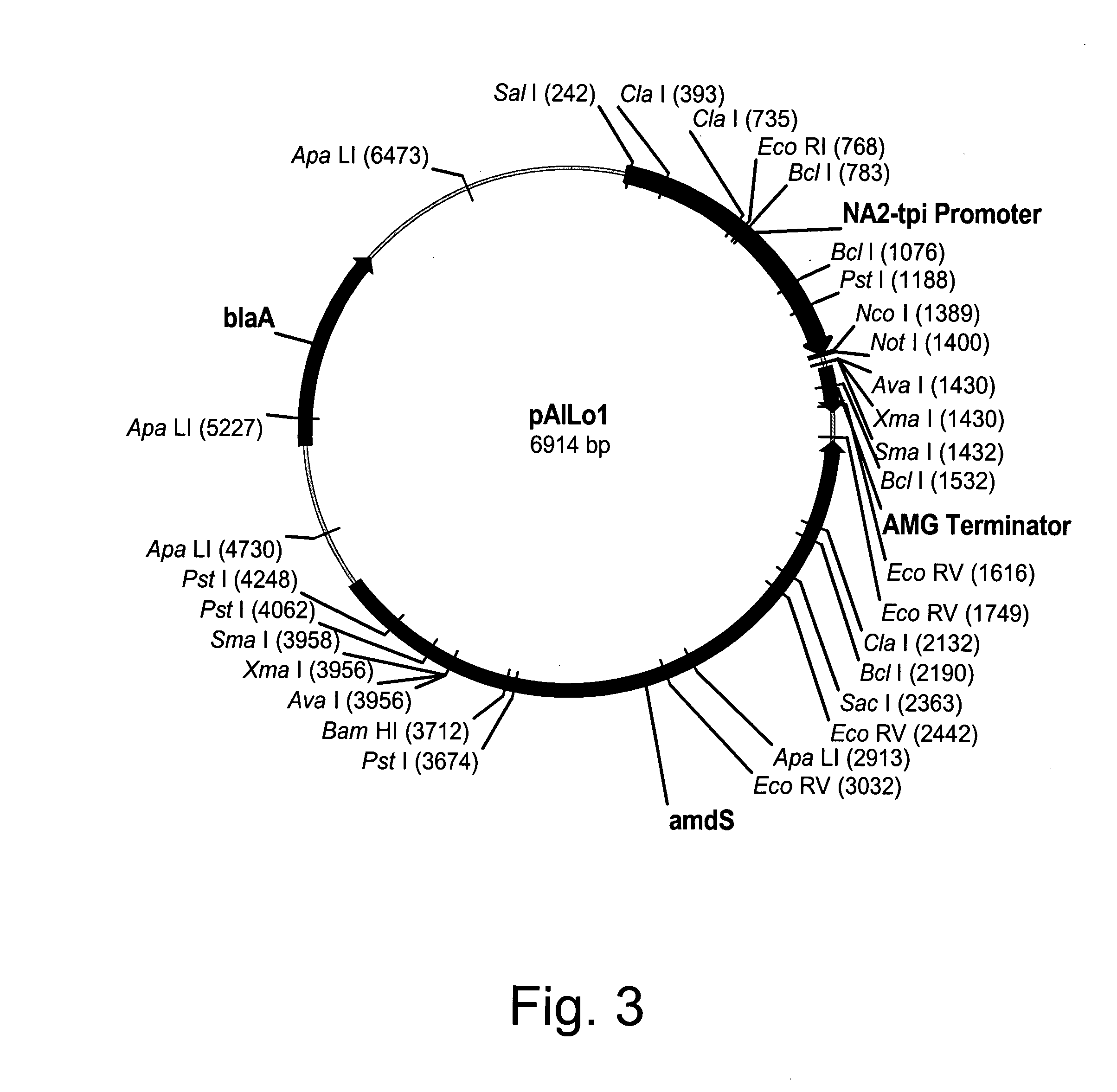Polypeptides having lipase activity and polynucleotides encoding same
a technology of lipase activity and polypeptide, which is applied in the field of isolated polypeptides having lipase activity and isolated polypeptides encoding the polypeptides, can solve the problems of few lipases that work under application conditions and can be produced with high yields by microbial fermentation
- Summary
- Abstract
- Description
- Claims
- Application Information
AI Technical Summary
Benefits of technology
Problems solved by technology
Method used
Image
Examples
example 1
Identification of Lipase Genes in the Partial Genomic Sequence of Aspergillus fumigatus
[0328] A tfasty search (Pearson, W. R., 1999, in Bioinformatics Methods and Protocols, S. Misener and S. A. Krawetz, ed., pp. 185-219) of the Aspergillus fumigatus partial genome sequence (The Institute for Genomic Research, Rockville, Md.) was carried out using as query a lipase sequence from Thermomyces lanuginosus (Accession No. 059952). Several genes were identified as putative lipases based upon an E value of less than 0.001 in the tfasty output. Two genomic regions of approximately 900 bp and 570 bp with greater than 33% identity to the query sequence at the amino acid level were chosen for further study. The gene models for the putative lipase genes were predicted based on homology to the Thermomyces lanuginosus lipase as well as conserved sequences present at the 5′ and 3′ ends of fungal introns.
example 2
Aspergillus fumigatus Genomic DNA Extraction
[0329]Aspergillus fumigatus was grown in 250 ml of potato dextrose medium in a baffled shake flask at 37° C. and 240 rpm. Mycelia were harvested by filtration, washed twice in TE (10 mM Tris-1 mM EDTA), and frozen under liquid nitrogen. Frozen mycelia were ground, by mortar and pestle, to a fine powder, which was resuspended in pH 8.0 buffer containing 10 mM Tris, 100 mM EDTA, 1% Triton X-100, 0.5 M guanidine-HCl, and 200 mM NaCl. DNase free RNase A was added at a concentration of 20 mg / liter and the lysate was incubated at 37° C. for 30 minutes. Cellular debris was removed by centrifugation, and DNA was isolated using a QIAGEN Maxi 500 column (QIAGEN Inc., Valencia, Calif.). The columns were equilibrated in 10 ml of QBT, washed with 30 ml of QC, and eluted with 15 ml of QF (all buffers from QIAGEN Inc., Valencia, Calif.). DNA was precipitated in isopropanol, washed in 70% ethanol, and recovered by centrifugation. The DNA was resuspended i...
example 3
Cloning of an Aspergillus fumigatus Lipase 1 Gene
[0330] Two synthetic oligonucleotide primers shown below were designed based on the predicted start and stop codons of the open reading frame to PCR amplify an Aspergillus fumigatus lipase 1 gene from the genomic DNA prepared in Example 2.
(SEQ ID NO: 17)Forward primer:5′-GAGACGCATGCTTCACAAGTATAG-3′(SEQ ID NO: 18)Reverse primer:5′-GTCACCTCTAGTTAATTAATCAGATTATCTTGC-3′
Bold letters represent coding sequence.
[0331] The fragment of interest was amplified by PCR using the Expand High Fidelity PCR System (Roche Diagnostics, Mannheim, Germany). One μM of each of the primers above were used in a PCR reaction containing 20 ng of Aspergillus fumigatus genomic DNA, 1×PCR buffer (Roche Diagnostics, Mannheim, Germany) with 1.5 mM MgCl2, 1 μl of a dATP, dTTP, dGTP, and dCTP mix (10 mM each), and 0.75 μl of DNA polymerase mix (3.5 U / μl; Roche Diagnostics, Mannheim, Germany) in a final volume of 50 μl. To amplify the fragment, an Eppendorf Masterc...
PUM
| Property | Measurement | Unit |
|---|---|---|
| pH | aaaaa | aaaaa |
| Tm | aaaaa | aaaaa |
| Tm | aaaaa | aaaaa |
Abstract
Description
Claims
Application Information
 Login to View More
Login to View More - R&D
- Intellectual Property
- Life Sciences
- Materials
- Tech Scout
- Unparalleled Data Quality
- Higher Quality Content
- 60% Fewer Hallucinations
Browse by: Latest US Patents, China's latest patents, Technical Efficacy Thesaurus, Application Domain, Technology Topic, Popular Technical Reports.
© 2025 PatSnap. All rights reserved.Legal|Privacy policy|Modern Slavery Act Transparency Statement|Sitemap|About US| Contact US: help@patsnap.com



